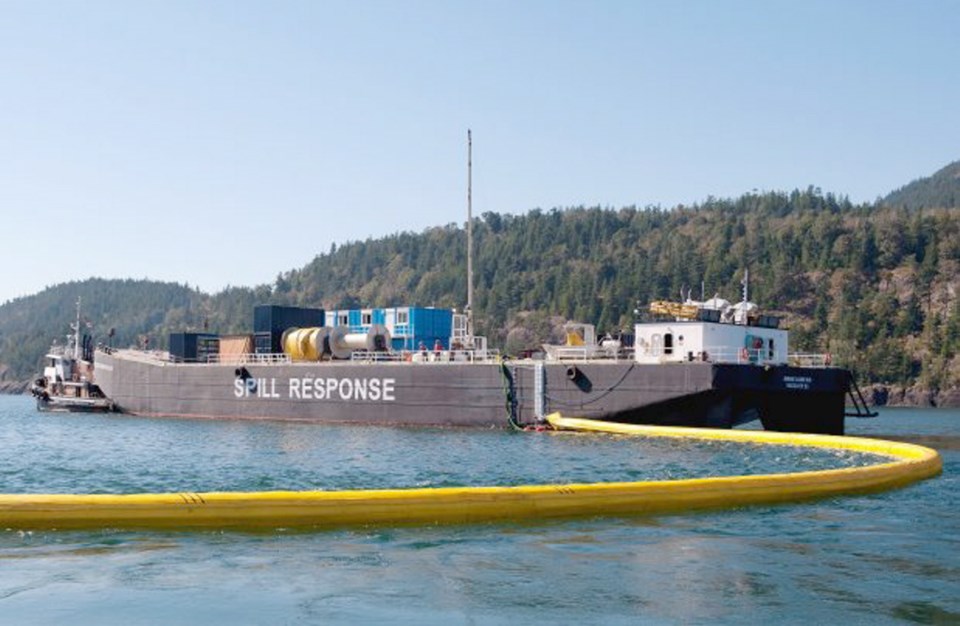Nearly two-thirds of the oil in a major tanker spill would be recovered in the Gulf Islands area within four days, according to computer modelling carried out for Trans Mountain $5.4-billion pipeline expansion.
That’s far greater than the figures cited by the tanker industry’s own organization, and more than twice as much as the best recovery estimate in a recent B.C. government-commissioned study.
The scenario, outlined in Kinder Morgan’s 15,000-page project application filed last month with the National Energy Board, is meant to show potential cleanup results for its proposed increased spill-response capacity. It is based on a major spill of 104,000 barrels of oil — about 40 per cent the size of the 1989 Exxon Valdez spill on the Alaska coast.
The findings, however, provide few assurances to environmentalists, who doubt that volume of oil could be recovered.
In response to the sixfold increase in annual tanker return trips to 408 in B.C. waters from its pipeline project, Kinder Morgan is recommending the industry-funded Western Canadian Marine Response Corp. (WCMRC) add new staging bases, which will require a tripling of staff to 90 and new purpose-built boats at a cost of up to $100 million.
That would cut in half the time for a full response effort, to 36 hours, and see the first responders arrive within six hours anywhere along the tanker route from the Burrard Inlet to the entrance of the Strait of Juan de Fuca.
The increase in bases and equipment would also increase the WCMRC’s capacity to handle a spill to 169,000 barrels of oil in southern B.C. waters, larger than the most likely spill if two compartments of the Aframax-sized tankers that dock at Burnaby’s Westridge Terminal were punctured.
Kinder Morgan has calculated that the probability of a major spill is once in about 2,400 years.
“Through the modelling and other work we did, what we found is the effectiveness of the spill response increased quite significantly the sooner you can get there and the sooner equipment is deployed,” says Michael Davies, Kinder Morgan’s director of marine development.
The computer modelling, carried out by EBA Engineering Consultants for Kinder Morgan, simulated a grounding at 8 p.m. on Aug. 17, 2012 at Arachne Reef at the southern tip of the Gulf Islands.
EBA concluded that 44.5 per cent of the spilled oil would be recovered at sea and 18.6 per cent recovered within booms around the ship. After four days, nearly 16 per cent of oil would end up on shore, and nine per cent would remain on the ocean. About seven per cent was estimated to evaporate, and about three per cent to dissolve.
Kinder Morgan’s estimates are based, in part, on testing it conducted on diluted bitumen in purpose-made tanks west of Edmonton, which showed it would remain floating after 10 days.
However, a federal government study released Tuesday raises serious questions about that conclusion.
The study found that diluted bitumen — also to be transported by the Northern Gateway pipeline — sinks in sea water when battered by waves and mixed with sediments.
The Salish Sea, which encompasses the Kinder Morgan tanker route, is considered to have high concentrations of sediments. Davies said the testing simulated ocean conditions but acknowledged Kinder Morgan did not use sediments in its testing.
Living Oceans executive director Karen Wristen said it’s a key concern because sediments would make the diluted bitumen heavier than sea water, causing it to sink below the ocean surface and making it next to impossible to recover.
Wristen noted Canadian authorities were unaware oil was headed their way following the Nestucca barge spill in 1988 in Washington state water because it had submerged. A week later, oil washed up on Vancouver Island shores.
“It would be impossible with conventional booms and skimmers: You simply could not corral it to keep it still to recover that much,” Wristen said of Kinder Morgan’s estimate it could recover nearly two-thirds of oil spilled.
Oil-spill expert Dr. Gerald Graham, who helped write a 1990 federal oil tanker report, said he couldn’t dispute Kinder Morgan’s figures but noted the company is relying on the diluted bitumen floating on the surface in their recovery estimates. Certainly, there are scientists that believe diluted bitumen will sink, said Graham, who provided expert advice to Living Oceans and Coastal First Nations on Enbridges’s $6.5-billion Northern Gateway project spill prevention and response plans.
“But even if they’re right and get two-thirds of the oil recovered, I’m worried about the other one third. One third of 104,000 barrels, that’s a heck of lot of oil,” said Graham, head of Victoria-based Worldocean Consulting, an oil-spill response and planning firm.
Additional spill findings also cast doubts on Kinder Morgan’s spill-recovery estimates.
According to the London-based International Tanker Owners Pollution Federation, even in ideal conditions in oceans around the world, only 10-15 per cent of oil is likely to be recovered.
A recent B.C. government-commissioned study by U.S.-based marine consulting firm Nuka Research & Planning Group LLC estimated that between nine and 31 per cent of a 70,000-barrel spill would be recovered after five days under several scenarios and seasons in southern B.C. waters.
Under Kinder Morgan’s proposals, five new spill-response bases would be established, including in the Roberts Banks area, Saanich peninsula and Nanaimo area. Two to three of the bases would be staffed 24 hours a day. WCMRC already has a base in Burnaby.
The WCMRC would need to increase full-time staffing to 90 from 30, increasing its $30-million annual operating budget, said WCMRC spokesman Michael Lowery. “It’s significant,” he said of the proposed capacity increases.
Several vessels would need to be constructed, including mini-barges and a high-speed skimming boat that is expected to take four to five years to construct.



